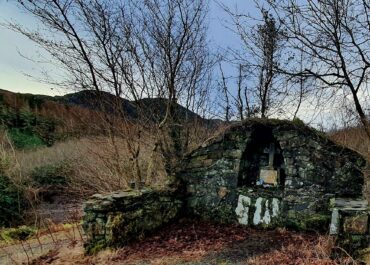Cross-slab, Reachlainn Uí Bhirn, Co. Donegal
In 1992, archaeologists made an intriguing discovery at Reachlainn Uí Bhirn, County Donegal, when they found a fragment of carved stone lying loose against the north wall of the local oratory.
Cross-slab, Reachlainn Uí Bhirn, Co. Donegal
The piece had become dislodged from the drystone structure built into the wall, revealing what appears to be part of an elaborate early Christian cross slab. Measuring just 20.7 by 12 centimetres and 3.3 centimetres thick, this small fragment offers a tantalising glimpse into the sophisticated stone carving traditions of medieval Ireland.
The fragment preserves part of one limb of what was clearly a much larger decorative cross. Three parallel grooves mark out the cross’s outline, with the central groove expanding into a distinctive T-shape at its terminal. This design technique, known as false relief, creates the illusion of a raised cross by carving away the surrounding stone rather than projecting the cross itself from the surface. The presence of a double-ribbon outline and expanded terminal suggests this was no ordinary grave marker; these features indicate a level of artistic sophistication that sets it apart from other surviving carvings on the island.
According to archaeologist Michael Herity, who documented the find in 1995, this fragment represents possibly the most accomplished stone carving to survive from the site. The quality of workmanship points to a skilled craftsperson working within the established traditions of Irish ecclesiastical art, creating monuments that served both as markers of faith and demonstrations of artistic achievement. Though only a small portion remains, this fragment helps us understand the rich visual culture that once flourished in this corner of Donegal, where carved crosses marked sacred spaces and commemorated the dead.


